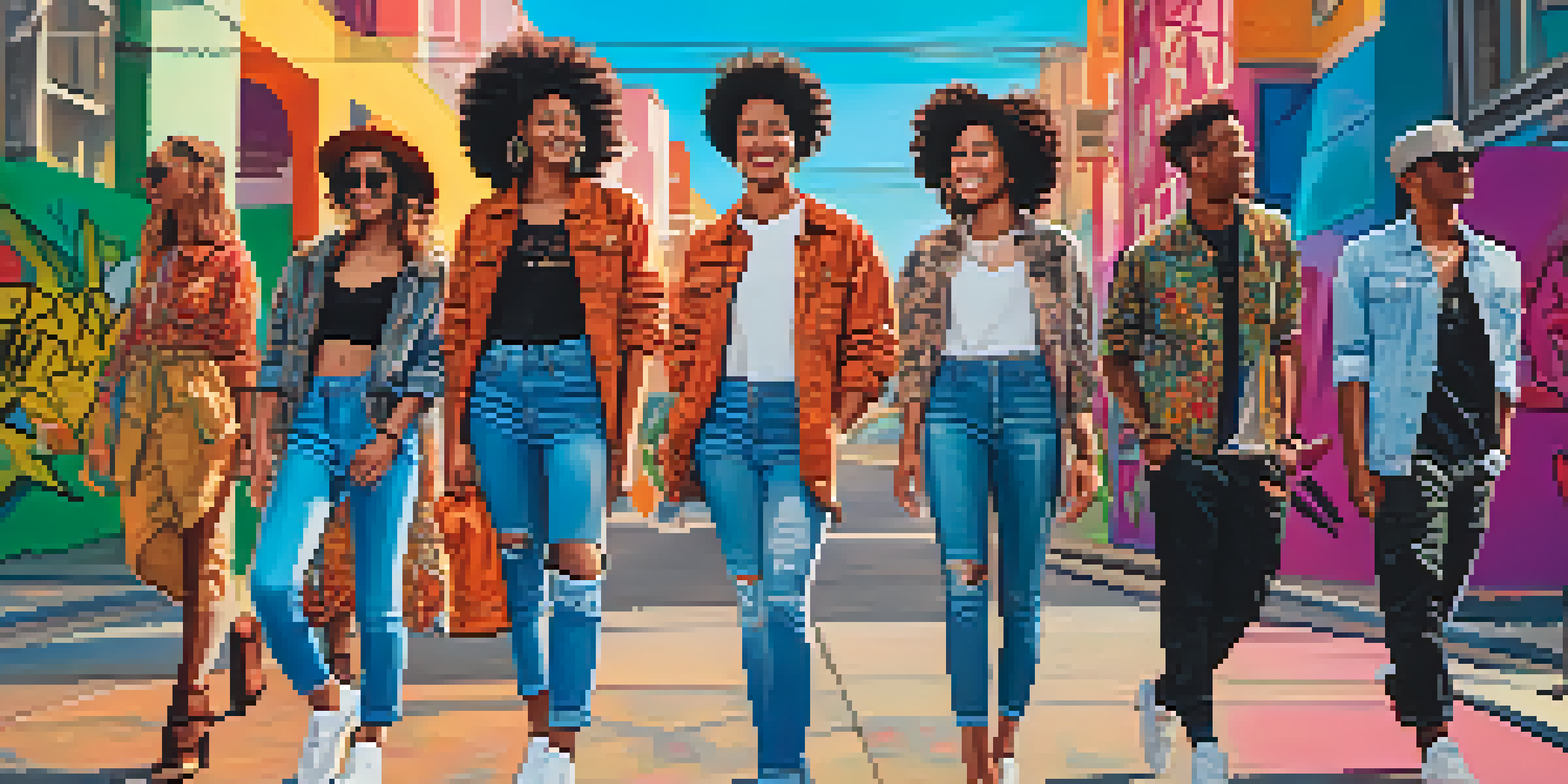The Role of Social Media in Shaping Fashion Trends Globally

The Rise of Social Media Influencers in Fashion
In recent years, social media influencers have become pivotal in the fashion industry. These individuals, often with large followings, showcase their personal style and collaborate with brands, making fashion more accessible and relatable. For instance, someone like Chiara Ferragni has transformed her passion for fashion into a global brand, influencing millions with just a few posts.
Influencers are the new celebrities, and they have the power to shape opinions and trends more than traditional advertising ever could.
Social media platforms like Instagram and TikTok allow influencers to reach audiences directly, bypassing traditional advertising channels. This direct line of communication creates a sense of authenticity and trust, which is crucial in the fashion world. Followers often feel more connected to influencers than to brands, leading to greater engagement and brand loyalty.
Moreover, influencers often set trends that resonate with their audience's lifestyle, making fashion feel more personal. When followers see their favorite influencers wearing a certain outfit, it inspires them to replicate that style, thus driving trends that may not have originated from high-fashion runways.
The Power of User-Generated Content in Fashion
User-generated content (UGC) has become a vital part of the fashion landscape, thanks to social media. Everyday users posting their outfits and styling tips contribute to a more diverse representation of fashion. This democratization of style allows people from all walks of life to share their unique fashion sense, fostering a sense of community.

Platforms like TikTok have popularized fashion challenges and trends, where users create and share their interpretations of a particular style. For example, the 'Get Ready With Me' videos not only showcase personal style but also inspire others to experiment with their wardrobe. This collaborative aspect of fashion helps break down traditional barriers, encouraging creativity.
Influencers Redefine Fashion Access
Social media influencers have transformed how fashion is perceived and accessed, creating a more relatable and engaging experience for followers.
Additionally, brands are increasingly recognizing the value of UGC in their marketing strategies. By featuring real customers in their campaigns, brands can resonate more with their audience, making their products feel more relatable and desirable.
Social Media as a Trend Forecasting Tool
Social media has evolved into a powerful tool for fashion trend forecasting. Fashion brands and designers often turn to platforms like Instagram and Pinterest to gauge what styles are gaining traction among consumers. By monitoring trending hashtags and popular posts, they can identify emerging trends before they hit the mainstream.
Fashion is not something that exists in dresses only. Fashion is in the sky, in the street, fashion has to do with ideas, the way we live, what is happening.
For instance, if a particular color or style starts appearing frequently in user posts, brands can quickly adapt their collections to align with these trends. This real-time feedback loop allows fashion companies to stay relevant and responsive to consumer preferences.
Moreover, analytics tools can track engagement rates and audience interactions, giving brands valuable insights into consumer behavior. This data-driven approach helps fashion businesses make informed decisions, ensuring they are always a step ahead in the competitive industry.
The Global Reach of Fashion Through Social Media
One of the remarkable aspects of social media is its ability to transcend geographical boundaries. Fashion trends that emerge in one part of the world can quickly spread globally, thanks to the internet. For example, street styles from Tokyo or Paris can inspire fashion enthusiasts in New York or São Paulo within days.
This global exchange of fashion ideas not only enriches personal style but also fosters cultural appreciation. When people share their local fashion scenes on social media, it invites others to explore and embrace diverse styles that they might not have encountered otherwise.
User-Generated Content Thrives
User-generated content fosters a diverse representation of fashion, encouraging creativity and community among everyday users.
Additionally, brands can launch international campaigns that tap into various cultural influences, creating a more inclusive fashion landscape. This interconnectedness allows for a more vibrant and eclectic mix of styles, reflecting the world’s rich diversity.
Sustainability and Ethical Fashion Movements Online
Social media has played a crucial role in raising awareness about sustainability and ethical fashion. As consumers become more conscious of their purchasing decisions, they turn to platforms like Instagram to discover brands that prioritize eco-friendly practices. Hashtags such as #SustainableFashion and #EthicalFashion are prevalent, fostering a community of like-minded individuals.
Influencers and activists use their platforms to educate their audience about the environmental impact of fast fashion, encouraging them to support sustainable brands. This shift in consumer mindset is pushing fashion companies to adopt more ethical practices, responding to the demand for transparency.
Moreover, movements like 'slow fashion' have gained traction, emphasizing quality over quantity. Social media enables these messages to spread quickly, inspiring individuals to make more thoughtful choices about their wardrobes.
The Impact of Fashion Challenges and Trends on Social Media
Fashion challenges on social media have become a fun way to engage users and spark creativity. Trends like the '30-day fashion challenge' encourage participants to remix their wardrobe and showcase their creativity, often resulting in unexpected combinations. These challenges not only inspire individual expression but also create a sense of community among participants.
Additionally, viral trends can significantly impact the fashion industry as a whole. A single viral video can lead to a sudden surge in demand for a particular item, forcing brands to quickly adapt their inventory. For example, when a specific style of sneaker gains popularity on TikTok, brands scramble to produce similar designs to meet consumer interest.
Social Media Drives Trend Forecasting
Brands utilize social media to forecast trends by monitoring consumer preferences and adapting their collections in real-time.
As these challenges and trends circulate, they often lead to collaborations between users and brands, further blurring the lines between consumer and creator. This dynamic fosters a more inclusive fashion environment, where everyone has a voice.
The Future of Fashion in the Age of Social Media
Looking ahead, the role of social media in shaping fashion trends is likely to grow even stronger. With advancements in technology and platforms continually evolving, we can expect to see even more innovative ways for users to interact with fashion. Virtual reality and augmented reality are already beginning to change how consumers shop and experience fashion online.
Furthermore, as social media becomes more integrated into our daily lives, the fashion industry will continue to adapt to new consumer behaviors. Brands that embrace this change and leverage user engagement will likely thrive in the future landscape of fashion.

Ultimately, the relationship between social media and fashion is symbiotic; as trends evolve, so too does the way we express ourselves. This ever-changing dynamic ensures that fashion remains exciting and accessible for all.